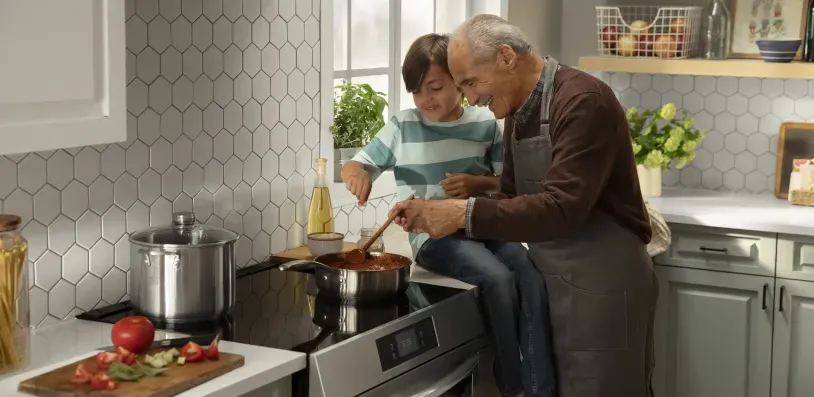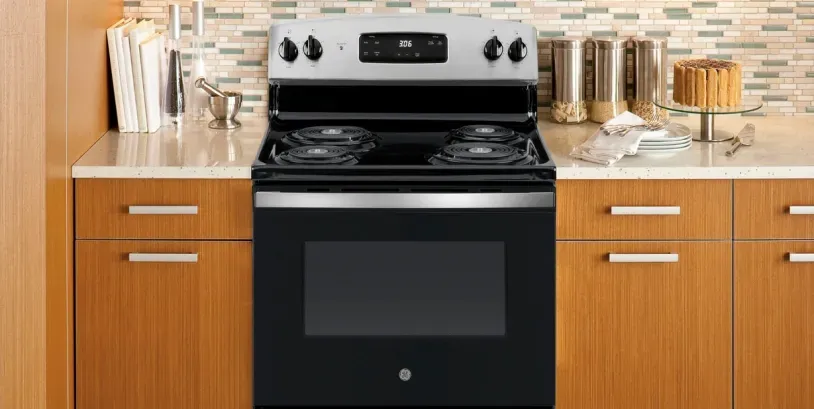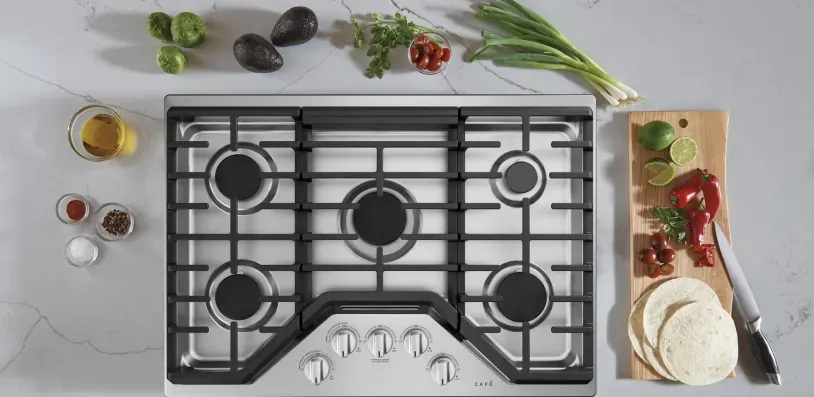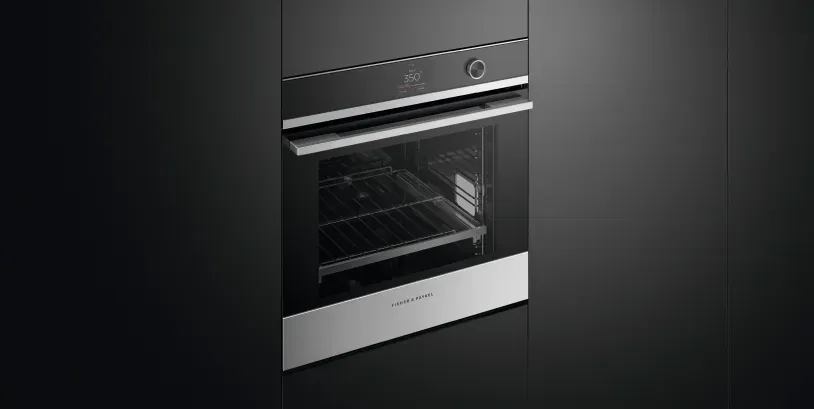Induction vs Electric Appliances: What's Better?
Wed May 29 2024
- Kitchen Appliances
Dreaming of perfectly cooked meals and lower energy bills? With the right appliances, it's all within reach! Choosing between induction and electric appliances can feel confusing if you’re unfamiliar with the differences and similarities, but we're here to break down the pros and cons of each so you can select the best fit for your home.
SHOP INDUCTION COOKTOPS
SHOP APPLIANCES
SHOP ELECTRIC COOKTOPS
What Are Induction Appliances?

Imagine a cooktop that heats your pan directly, without getting hot itself. Sounds like magic, right? Well, it's actually science! Induction appliances use the power of magnetism.
When you switch on an induction cooktop, a coil underneath the sleek surface comes to life, creating an invisible magnetic field. When you place a pot or pan made with iron (like a cast iron skillet) on the cooktop, the magnetism gets to work, creating electrical currents right inside the cookware. These currents are what actually heat up your pan, making it perfect for searing steaks or simmering delicate sauces.
One of the biggest advantages of induction cooking is safety. Since the heat is generated in the pan itself, the cooktop surface stays relatively cool. Induction technology isn't limited to cooktops. Induction ranges combine the precision and efficiency of an induction cooktop with the versatility of an electric oven, making it a great comprehensive appliance for any kitchen.
Let's explore the different types of induction appliances and how they can help you in the kitchen:
Common Types of Induction Appliances
• Induction Cooktops: These sleek, flat cooktops are known for their rapid heating capabilities and precise temperature control. They offer a smooth surface that is easy to clean and integrate seamlessly into modern kitchen designs.
• Induction Ranges: Combining an induction cooktop with an electric oven, induction ranges provide the best of both worlds. They deliver the speed and efficiency of induction cooking on the stovetop while offering the versatility of a conventional oven for baking and roasting.

What Are Electric Appliances?
For generations, electric appliances have been the trusty companions in our kitchens. They're the no-fuss appliances you can always count on. When you plug in your electric appliance, the current travels through a special heating element wire. This element transforms the electrical energy into heat.
Imagine a lightbulb filament, but it gets really hot instead of glowing. Depending on the appliance, this heat is transferred directly to your pan, pot, or oven cavity. In cooktops, you might see coils or flat metal plates that heat up, while ovens often use hidden coils or radiant heating elements that warm the entire space.
Electric appliances are straightforward and reliable, making them perfect for kitchens of all shapes and sizes. Let's explore the different types of electric appliances and how they can help you in the kitchen:
Common Types of Electric Appliances
• Electric Cooktops: Electric cooktops come in different designs, including coil and smooth glass-ceramic surfaces. Coil cooktops feature visible heating elements, while glass-ceramic cooktops have heating elements beneath a smooth, easy-to-clean surface. Electric cooktops are known for their durability and ease of use.
• Electric Ranges: Combining an electric cooktop with an electric oven, electric ranges provide a versatile cooking solution. They are available in various configurations and sizes, offering features such as convection baking, self-cleaning modes, and precise temperature control.
• Electric Ovens: Standalone electric ovens are popular for their consistency and even heating, making them ideal for baking, roasting, and broiling. They often come with advanced features like multiple cooking modes, timers, and digital controls.
Induction vs Electric: Key Differences
Both induction and electric appliances have their strengths, but which one belongs in your kitchen? Let’s take a look at the key differences between the two:
Heating Efficiency
• Induction: Induction cooktops are very efficient, transferring up to 90% of the energy directly to the cookware. This means less heat is wasted, and cooking times are significantly reduced. Induction technology ensures rapid and even heating, which is ideal for precise cooking.
• Electric: Electric cooktops transfer about 70-75% of their energy to the cookware. While still efficient, they are slower to heat up and cool down than induction cooktops. The heating elements take time to reach the desired temperature and retain heat longer after being turned off.
Cooking Speed
• Induction: One of the standout features of induction cooking is its speed. Induction cooktops can boil water and heat food much faster than electric cooktops. This speed is due to the direct transfer of heat to the cookware, eliminating the need to heat an intermediary element.
• Electric: Electric cooktops take longer to reach the desired temperature and cook food. The heating elements must first warm up before transferring heat to the cookware, resulting in slower overall cooking times.
Energy Consumption
• Induction: Because of their high efficiency, induction cooktops consume less energy than electric cooktops. This efficiency saves on energy bills and reduces the environmental impact.
• Electric: Electric cooktops are less energy-efficient due to heat loss during the cooking process. They use more electricity to achieve the same cooking results as induction cooktops.
Safety Features
• Induction: Due to their design, induction cooktops are inherently safer. The cooktop surface remains cool because only the cookware gets heated. Additionally, most induction cooktops have safety features like automatic shut-off and pan detection, which turn off the cooktop when no compatible cookware is detected.
• Electric: Electric cooktops can pose a burn risk because the heating elements and surface remain hot long after cooking. However, many modern electric cooktops come with safety features like indicator lights to show when the surface is still hot.
Ease of Cleaning
• Induction: The smooth, flat surface of induction cooktops makes them exceptionally easy to clean. Since the cooktop surface doesn’t get hot, spills don’t burn onto the surface, allowing for quick and easy wipe-downs.
• Electric: While glass-ceramic electric cooktops are also relatively easy to clean, spills can sometimes burn onto the surface, requiring more effort to clean. Coil cooktops can be more challenging to clean due to their design and exposed elements.

Pros and Cons of Induction and Electric Appliances
Pros and Cons of Induction and Electric Appliances Choosing between induction and electric appliances involves weighing their respective advantages and disadvantages, including considerations around cost. Here’s a detailed look at the pros and cons of each type to help you make an informed decision:
Pros of Induction Appliances
• Faster Cooking Times: Induction cooktops heat up quickly, significantly reducing cooking times. This efficiency is particularly beneficial for boiling water and searing meats.
• Precise Temperature Control: Induction technology allows for precise adjustments in temperature, providing better control over cooking processes.
• Energy Efficiency: Induction cooktops are highly energy-efficient, with up to 90% of the energy used directly transferred to the cookware.
• Safety Features: The cooktop surface remains cool to the touch, reducing the risk of burns. Additionally, induction cooktops often come with automatic shut-off and pan detection features.
• Ease of Cleaning: The smooth, flat surface of induction cooktops makes them easy to clean, as spills don’t burn onto the surface.
Cons of Induction Appliances
• Requires Specific Cookware: Induction cooktops require cookware made of ferrous (iron-based) materials. Non-magnetic cookware like aluminum or copper won’t work unless they have a magnetic base.
• Higher Upfront Cost: Induction cooktops and ranges generally have a higher initial purchase cost compared to electric models.
• Learning Curve: Some users may need time to adjust to the speed and responsiveness of induction cooking.
Cost Considerations of Electric Appliances
• Initial Purchase: Induction cooktops and ranges tend to be more expensive upfront. However, their energy efficiency can lead to savings on utility bills over time.
• Cookware: If you don’t already have compatible cookware, you may need to invest in new pots and pans, adding to the initial expense.
• Operating Costs: Lower energy consumption can result in reduced operating costs in the long run, making induction appliances more cost-effective over time.
Pros of Electric Appliances
• Wide Range of Options: Electric appliances are available in various designs and price points, offering flexibility for different budgets and kitchen styles.
• Reliable and Easy to Use: Electric cooktops and ovens are straightforward and familiar to most users, making them easy to operate.
• Even Heating: Electric ovens, in particular, are known for their even heating, making them excellent for baking.
Cons of Electric Appliances
• Slower Cooking Times: Electric cooktops take longer to heat up and cool down, which can extend cooking times.
• Less Energy Efficient: Electric cooktops are less energy-efficient compared to induction, resulting in higher energy consumption.
• Hot Surface: The cooktop surface remains hot after cooking, posing a burn risk.
Cost Considerations of Electric Appliances
• Initial Purchase: Electric cooktops and ranges are generally more affordable upfront compared to induction models.
• Operating Costs: While electric appliances are less energy-efficient, they still provide reliable performance. However, higher energy consumption can lead to increased utility bills over time.
• Maintenance and Repair: Electric appliances are typically easier and cheaper to repair and maintain compared to induction appliances, which can have more complex technology.
Explore Induction and Electric Appliances at Van Vreede’s
Both induction and electric appliances have unique advantages and potential drawbacks. So, which is better: induction or electric appliances?
Induction appliances are known for their speed, energy efficiency, and precise temperature control, making them a favorite among modern chefs who value performance and innovation. On the other hand, electric appliances offer reliability, ease of use, and compatibility with all types of cookware, making them a tried-and-true choice for many households. The true answer lies in what you need out of your cooktop.
At Van Vreedes, your trusted source for appliances in Green Bay, we're here to equip your kitchen for success. We also offer a wide range of other furniture products for your home, including sofas, sectionals, tables, and more. Feel free to contact us or visit our website or showroom in Green Bay, Appleton, or Oshkosh, to learn more about induction and electric appliances and take a look at our offerings.
Related Readings:
- Convection Vs. Conventional Ovens
- Selecting the Best Double Wall Oven For Your Kitchen

FAQ About Induction and Electric Appliances
Is induction really better than electric?
Induction appliances offer several advantages over electric, including faster cooking times, greater energy efficiency, and precise temperature control. However, whether induction is better depends on your specific needs and cooking habits. Induction is ideal for those who prioritize speed and efficiency, while electric appliances provide reliability and compatibility with all cookware types.
What is the downside of an induction cooker?
One of the main downsides of an induction cooker is the need for compatible cookware. Induction cooktops only work with ferrous (magnetic) materials like cast iron and certain stainless steel. Additionally, induction cooktops can be more expensive upfront compared to electric models, and there can be a learning curve for users not familiar with the technology.
Do chefs prefer electric or induction?
Many professional chefs prefer induction cooktops for their speed, precision, and energy efficiency. The ability to make quick temperature adjustments and the even distribution of heat make induction a favorite in professional kitchens. However, some chefs still prefer electric cooktops for their reliability and consistent heating, particularly in baking.
Can I use my existing cookware on an induction cooktop?
Only certain types of cookware work with induction cooktops. To check if your existing cookware is compatible, see if a magnet sticks to the bottom of the pot or pan. If it does, it will work with induction. Common materials that work include cast iron, enameled cast iron, and some types of stainless steel. Non-magnetic materials like aluminum, copper, and glass will not work unless they have a magnetic layer added to the bottom.
Related Articles
Welcome to our website! As we have the ability to list over one million items on our website (our selection changes all of the time), it is not feasible for a company our size to record and playback the descriptions on every item on our website. However, if you have a disability we are here to help you. Please call our disability services phone line at (920) 730-4477 during regular business hours and one of our kind and friendly personal shoppers will help you navigate through our website, help conduct advanced searches, help you choose the item you are looking for with the specifications you are seeking, read you the specifications of any item and consult with you about the products themselves. There is no charge for the help of this personal shopper for anyone with a disability. Finally, your personal shopper will explain our Privacy Policy and Terms of Service, and help you place an order if you so desire.
Copyright © 2009 - 2025 Company All Rights Reserved.
This site is protected by reCAPTCHA and the Google Privacy Policy and Terms of Service apply.

